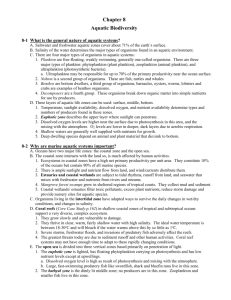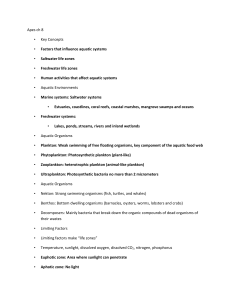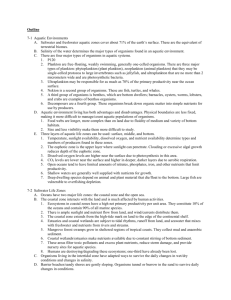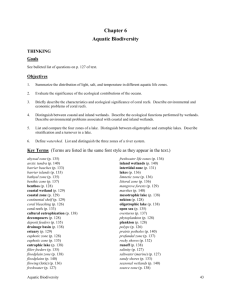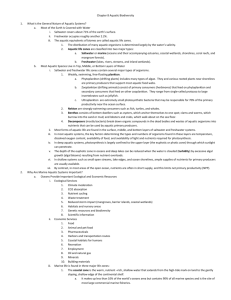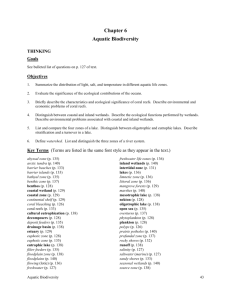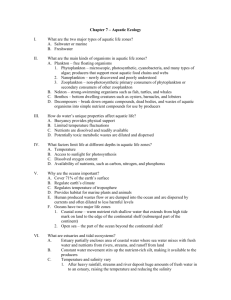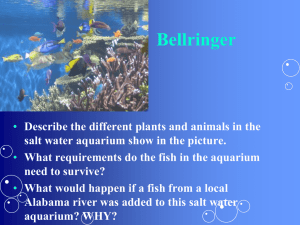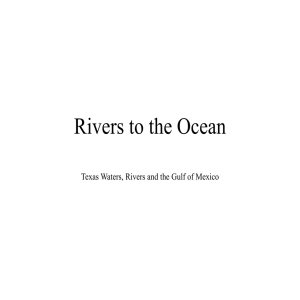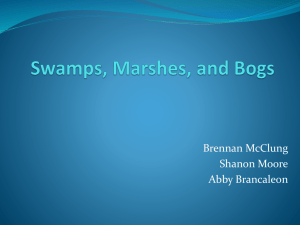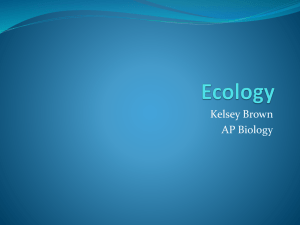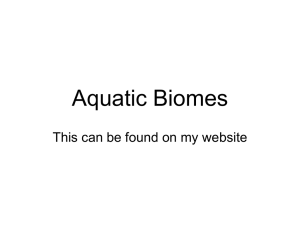Aquatic Biodiversity
advertisement
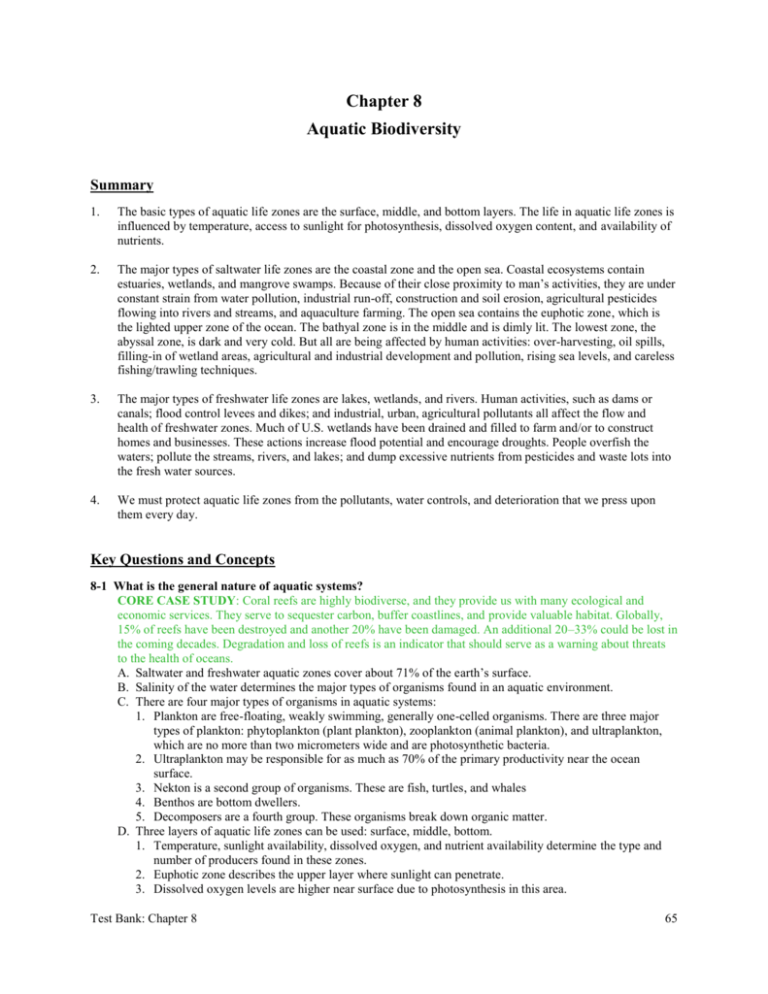
Chapter 8 Aquatic Biodiversity Summary 1. The basic types of aquatic life zones are the surface, middle, and bottom layers. The life in aquatic life zones is influenced by temperature, access to sunlight for photosynthesis, dissolved oxygen content, and availability of nutrients. 2. The major types of saltwater life zones are the coastal zone and the open sea. Coastal ecosystems contain estuaries, wetlands, and mangrove swamps. Because of their close proximity to man’s activities, they are under constant strain from water pollution, industrial run-off, construction and soil erosion, agricultural pesticides flowing into rivers and streams, and aquaculture farming. The open sea contains the euphotic zone, which is the lighted upper zone of the ocean. The bathyal zone is in the middle and is dimly lit. The lowest zone, the abyssal zone, is dark and very cold. But all are being affected by human activities: over-harvesting, oil spills, filling-in of wetland areas, agricultural and industrial development and pollution, rising sea levels, and careless fishing/trawling techniques. 3. The major types of freshwater life zones are lakes, wetlands, and rivers. Human activities, such as dams or canals; flood control levees and dikes; and industrial, urban, agricultural pollutants all affect the flow and health of freshwater zones. Much of U.S. wetlands have been drained and filled to farm and/or to construct homes and businesses. These actions increase flood potential and encourage droughts. People overfish the waters; pollute the streams, rivers, and lakes; and dump excessive nutrients from pesticides and waste lots into the fresh water sources. 4. We must protect aquatic life zones from the pollutants, water controls, and deterioration that we press upon them every day. Key Questions and Concepts 8-1 What is the general nature of aquatic systems? CORE CASE STUDY: Coral reefs are highly biodiverse, and they provide us with many ecological and economic services. They serve to sequester carbon, buffer coastlines, and provide valuable habitat. Globally, 15% of reefs have been destroyed and another 20% have been damaged. An additional 20–33% could be lost in the coming decades. Degradation and loss of reefs is an indicator that should serve as a warning about threats to the health of oceans. A. Saltwater and freshwater aquatic zones cover about 71% of the earth’s surface. B. Salinity of the water determines the major types of organisms found in an aquatic environment. C. There are four major types of organisms in aquatic systems: 1. Plankton are free-floating, weakly swimming, generally one-celled organisms. There are three major types of plankton: phytoplankton (plant plankton), zooplankton (animal plankton), and ultraplankton, which are no more than two micrometers wide and are photosynthetic bacteria. 2. Ultraplankton may be responsible for as much as 70% of the primary productivity near the ocean surface. 3. Nekton is a second group of organisms. These are fish, turtles, and whales 4. Benthos are bottom dwellers. 5. Decomposers are a fourth group. These organisms break down organic matter. D. Three layers of aquatic life zones can be used: surface, middle, bottom. 1. Temperature, sunlight availability, dissolved oxygen, and nutrient availability determine the type and number of producers found in these zones. 2. Euphotic zone describes the upper layer where sunlight can penetrate. 3. Dissolved oxygen levels are higher near surface due to photosynthesis in this area. Test Bank: Chapter 8 65 4. O2 levels are lower in deeper, dark layers due to aerobic respiration and because less O2 gas dissolves in deeper and colder water. 5. Productivity in open oceans tends to be limited by amounts of nitrates, phosphates, iron, and other nutrients. 6. Shallow waters are generally well supplied with nutrients for growth. 8-2 Why are marine aquatic systems important? A. Oceans have two major life zones: the coastal zone and the open sea. B. The coastal zone interacts with the land, and so is much affected by human activities. 1. Ecosystems in coastal zones have a high net primary productivity per unit area. They constitute 10% of the oceans and contain 90% of all marine species. 2. There is ample sunlight, and nutrients flow from land and wind/currents distribute them. 3. The coastal zone extends from the high-tide mark on land to the edge of the continental shelf. 4. Estuaries and coastal wetlands are subject to tidal rhythms, runoff from land, and seawater that mixes with freshwater and nutrients from rivers and streams. 5. Mangrove forest swamps grow in sheltered regions of tropical coasts. 6. Coastal wetlands/estuaries make nutrients available due to constant stirring of bottom sediment. 7. These areas filter toxic pollutants and excess plant nutrients, reduce storm damage, and provide nursery sites for aquatic species. 8. Humans are destroying/degrading these ecosystems; one-third have already been lost. C. Organisms living in the intertidal zone have adapted ways to survive the daily changes in wet/dry conditions and changes in salinity. D. Barrier beaches/sandy shores are gently sloping. Organisms tunnel or burrow in the sand to survive daily changes in conditions. E. Low, sandy, narrow islands that form offshore from a coastline are barrier islands. They generally run parallel to the shore. 1. The islands help protect the mainland, estuaries, and coastal wetlands from heavy storm damage. 2. Sand is constantly shifting due to winds and parallel currents along the islands. F. Coral reefs in shallow coastal zones of tropical and subtropical oceans support a very diverse, complex ecosystem. 1. They grow slowly and are vulnerable to damage. 2. They thrive in clear, warm, fairly shallow water with a high salinity. The ideal water temperature is between 18–30oC and will bleach if the water warms above this by so much as 1oC. 3. The greatest threats today are due to sediment runoff and other human activities. Coral reef systems may not have enough time to adapt to these rapidly changing conditions. G. The open sea is divided into three vertical zones based primarily on penetration of light. 1. The euphotic zone is lighted, has floating phytoplankton carrying on photosynthesis, and has low nutrient levels except at upwellings. a. Dissolved oxygen level is high. 2. The bathyal zone is the dimly lit middle zone; no producers are in this zone. Zooplankton and smaller fish live in this zone. 3. The abyssal zone is dark, very cold with little dissolved oxygen. a. Organisms in this area are deposit feeders, or filter feeders. b. Hydrothermal vents are present in some areas with specialized bacteria that feed on chemical nutrients and are food for other organisms c. Low average primary productivity and NPP occurs, but oceans are so large they make the largest contribution to NPP overall. 8-3 How have human activities affected marine ecosystems? A. Human activities are greatly affecting the ecological and economic services provided by marine ecosystems. 1. Studies suggest 41%of the world’s ocean area has been heavily affected by human activities. 2. About 45% of the global population lives along coasts, and that figure is expected to rise. 3. Major threats to marine systems include coastal development, over-fishing, non-point and point source pollution, habitat destruction, invasive species, climate change, and pollution. 66 Aquatic Biodiversity CASE STUDY: Chesapeake Bay is the largest estuary in the United States. Population pressures and pollution have led to severe environmental problems in the region. An integrated program involving diverse groups has been effective in recent years at alleviating the severity of some of these pressures. Nevertheless, a recent decline in funding has slowed progress and environmental problems remain. 8-4 Why are freshwater ecosystems important? A. Freshwater life zones contain less than 1% by volume of salt. These zones include standing (lentic) bodies—such as lakes, ponds, and wetlands—and flowing (lotic) systems such as streams and rivers. B. Lakes are large natural bodies of standing water found in depressions. 1. Rainfall, melting snow, and stream drainage feed lakes. 2. Generally consist of four distinct zones depending on depth and distance from shore. a. Littoral zone is open, sunlit surface water away from shore and is the most productive area for food and oxygen production. b. Profundal zone is deep oven water too dark for photosynthesis. Oxygen levels are lower. c. Benthic zone consists of decomposers and detritus feeders. Fish swim from one zone to another. Sediment washing and dropping detritus feed this area. C. Stratification of water occurs in deep temperate lakes into temperature zones; no mixing occurs. D. During fall and spring, have turnover of water that brings up nutrients, reoxygenates bottom levels, and evens out water temperature. E. Lakes are described with reference to their plant nutrients. 1. An oligotrophic lake is one that has been newly formed, has a small supply of plant nutrients. 2. A eutrophic lake has a large or excessive supply of nutrients. Typically are shallow with murky brown or green water with low visibility and high net primary productivity. 3. Lakes between these two extremes are called mesotrophic lakes. F. Waters flowing from mountains to sea create different aquatic conditions and habitats. 1. Surface water does not sink into the ground. 2. Runoff is surface water that flows into streams and rivers, and the area it drains is called a watershed or drainage basin. G. Three aquatic life zones, each with different conditions, can be identified along stream flow. 1. The source zone is narrow and fast moving. It dissolves large amounts of oxygen from air, and most plants are attached to rocks. Light is available, but is not very productive. 2. The transition zone forms wider, deeper streams that flow down gentler slopes. The water is warmer, with more nutrients, which supports more producers, but has slightly lower dissolved oxygen. 3. The floodplain zone has wider, deeper rivers. Water temperature is warmer; less dissolved oxygen is present and flow is slower. H. Streams are fairly open ecosystems and receive many nutrients from surrounding lands. I. Farms, power plants, cities, and recreation areas are often found in floodplains. This also increases excessive nutrient input and pollutant input into the river system. CASE STUDY: Coastal deltas and wetlands provide protection against flooding. When these areas are degraded, the effects of storm events can be intensified. Many deltas are shrinking rather than being maintained, because the sediments that normally build them are trapped behind dams upstream. Much of the city of New Orleans is now below sea level for this reason. Levees offer a temporary solution but will usually be breached by a strong storm. Climate change also suggests that sea level will be rising further. We now understand these processes, but the question is whether or not we will apply them to the systems that are at risk. J. Inland wetlands cover the land for a part of all of each year. Wetlands include swamps, marshes, prairie potholes, floodplains, and arctic tundra in summer. 8-5 How have human activities affected freshwater ecosystems? A. Human activities have four major impacts on freshwater systems. 1. Dams, diversions of canals fragment ~60% of world’s large rivers and destroy habitats. 2. Flood control dikes and levees alter rivers and destroy aquatic habitats. 3. Cities and farmlands add pollutants. Test Bank: Chapter 8 67 CASE STUDY: More than half of the inland wetlands that existed in the United States in the 1600s no longer exist. About 80% are now used to grow crops and the rest have been lost to mining, forestry, and oil and gas extraction. This has greatly increased the flood and drought damage in the United States. Key Terms benthos (p. 164) coastal wetland (p. 166) coastal zone (p. 165) cultural eutrophication (p. 175) decomposers (p. 164) drainage basin (p. 176) inland wetlands (p. 178) intertidal zone (p. 168) lakes (p. 174) mesotrophic lake (p. 176) nekton (p. 164) open sea (p. 170) plankton (p. 164) runoff (p. 176) surface water (p. 176) watershed (p. 176) Additional Video Resources After the Storm (Documentary, free DVD or VHS) Looks at watersheds and their importance in various parts of the U.S. http://www.epa.gov/weatherchannel/video.html Blue Planet (Video series, Discovery Channel, 2001) Mammoth series, five years in the making, taking a look at the rich tapestry of life in the world's oceans. http://dsc.discovery.com/convergence/blueplanet/blueplanet.html Conserving America: The Wetlands (PBS, 1994) A four-part series on American Conservation of wetlands Conserving America: The Rivers (PBS, 1994) Conserving America: The Challenge on the Coast (PBS, 1994) Conserving America: The Wetlands (PBS, 1994) Last Journey for the Leatherback? Looks at the effects of overfishing on sea turtles. http://www.greentreks.org/naturalheroes/season2/lastjourney.asp Ocean Oasis (Documentary, San Diego Natural History Museum, 2001) Biodiversity in the Sea of Cortez, and the deserts of Baja. http://www.oceanoasis.org/toc.html We all Live Downstream (Documentary, 1991) A look at pollution in the Mississippi River and the effects on human health. http://www.videoproject.com/wea-281-v.html Web Resources Bridge http://www.vims.edu/bridge/ A variety of resources for teachers that may be adaptable to the college level. 68 Aquatic Biodiversity Centers for Ocean Sciences Education Excellence http://www.cosee.net/ Contains a variety of resources for ocean education. EPA Wetlands Education http://www.epa.gov/owow/wetlands/education/ Contains a variety of resources for teaching about the significance of wetlands. Aquatic Biodiversity 69 70 Test Bank: Chapter 8
